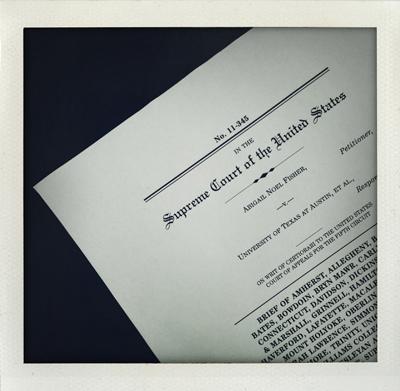September 5, 2012
In a show of support for the importance of diversity in higher education, Amherst College organized and led a group of other “highly selective” liberal arts schools from across the country in filing an amicus brief with the U.S. Supreme Court in the Fisher v. University of Texas case last month. The Court is scheduled in October to hear arguments in the case, which examines whether the University of Texas violated the U.S. Constitution and federal civil rights laws by using race as a factor in the school’s admission policy.

“We felt it was imperative to support the University of Texas, since Amherst has long recognized the educational importance of dialogue among individuals of diverse backgrounds and experiences, including individuals from traditionally underrepresented groups, “ said Amherst President Biddy Martin. “We are committed to maintaining a richly diverse learning environment that will prepare our students for our increasingly heterogeneous and global society.”
“The Supreme Court’s ruling in Fisher will have serious implications on the future composition of the college’s student body,” said Tom Parker, the college’s dean of admission and financial aid. By following the guidelines established in the Supreme Court’s landmark 2003 decision in Grutter v. Bollinger—which addressed the University of Michigan’s admission policies—Amherst has seen the percentage of its students who identify as students of color increase to more than 40 percent (as measured during the 2011–12 academic year, the most recent numbers available).
“We have clearly made great strides in finding and enrolling talented students from all kinds of backgrounds in recent years,” he noted. “Preventing us from considering race in our admission decisions would considerably hamper our efforts to build a robustly diverse student body in the future.”
The lead counsel for the amicus brief was Amherst alumnus and parent Charles Sims ’71, who filed it on behalf of Amherst and 36 other colleges and universities. This is the second time that Amherst and Sims have joined forces to lead such an effort. In 2003, the college—led by then-President Tom Gerety, a constitutional lawyer—organized and filed an amicus brief in the Grutter case. Gerety worked with Sims, his Yale Law School classmate, to prepare and file the brief.
In the case of Fisher v. University of Texas, the effort was led by Martin and Paul Murphy, the college’s legal and administrative counsel. Other signatories on the brief are Carlton, Davidson, Grinnell, Middlebury, Swarthmore and Williams Colleges, to name a few.
“Private colleges were created as engines of social change, and the court should consider the realities of selecting students in a society in which race still matters and the effects of discrimination and entrenched segregation still linger,” argues the brief. “The careful, thoughtful, well-considered efforts to attract more qualified students of color to apply to and matriculate at the colleges have enabled the colleges to better accomplish the missions they set for themselves, which include, among other things, educating students who, individually and collectively, will contribute most to—and gain most from—the educational process, and be most successful in using what they have learned for the benefit of the larger society.”
It continues: “All of [the] amici colleges, as part of their commitment to diversity and educational excellence, are cognizant of the interaction between campus diversity and educational attainment and all conclude that their diversity is an integral part of their educational strengths.”
Diversity has been “an integral part of [the] educational strengths” of Amherst since the college’s early days. Edward Jones, the first African-American student, graduated in 1826. Joseph Hardy Neesima of the Class of 1870 was the first Japanese student ever to earn a degree from a Western college and went on to found Doshisha University, Amherst’s sister institution in Kyoto.
The first two women to apply to the college, in 1871, were not admitted, but Trustee Henry Ward Beecher, Class of 1834 (and brother of writer Harriet Beecher Stowe, incidentally), once said, “If a woman is fully qualified, [Amherst’s] doors will be open to her.” It took many decades, but those doors opened when the college began hiring women as tenure-track professors in 1962 and became coeducational in 1975. The 2011 inauguration of Martin as its first woman president constituted another milestone in Amherst’s increasing diversity and gender equality.
In 1996, the college’s Board of Trustees articulated a commitment to diversity that Amherst still embraces today. “We … give special importance to the inclusion within our student body, our faculty and our staff of talented persons from groups that have experienced prejudice and disadvantage,” it reads. “We do so for the simplest, but most urgent, of reasons: because the best and brightest people are found in many places, not few; because our classrooms and residence halls are places of dialogue, not monologue; because teaching and learning at their best are conversations with persons other than ourselves about ideas other than our own.”